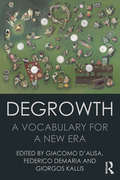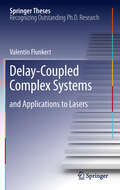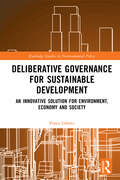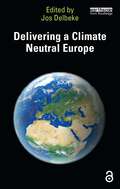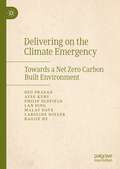- Table View
- List View
Deformation Theory of Algebras and Structures and Applications (Nato Science Series C: #247)
by Michiel Hazewinkel Murray GerstenhaberThis volume is a result of a meeting which took place in June 1986 at 'll Ciocco" in Italy entitled 'Deformation theory of algebras and structures and applications'. It appears somewhat later than is perhaps desirable for a volume resulting from a summer school. In return it contains a good many results which were not yet available at the time of the meeting. In particular it is now abundantly clear that the Deformation theory of algebras is indeed central to the whole philosophy of deformations/perturbations/stability. This is one of the main results of the 254 page paper below (practically a book in itself) by Gerstenhaber and Shack entitled "Algebraic cohomology and defor mation theory". Two of the main philosphical-methodological pillars on which deformation theory rests are the fol lowing • (Pure) To study a highly complicated object, it is fruitful to study the ways in which it can arise as a limit of a family of simpler objects: "the unraveling of complicated structures" . • (Applied) If a mathematical model is to be applied to the real world there will usually be such things as coefficients which are imperfectly known. Thus it is important to know how the behaviour of a model changes as it is perturbed (deformed).
Deformations of Mathematical Structures: Complex Analysis with Physical Applications
by Julian LawrynowiczSelected Papers from the Seminar on Deformations, Lódz-Lublin, 1985/87
Deformations of Spacetime Symmetries: Gravity, Group-Valued Momenta, and Non-Commutative Fields (Lecture Notes in Physics #986)
by Michele Arzano Jerzy Kowalski-GlikmanThis monograph provides an introduction to deformations of Poincaré symmetries focusing on models with a Lie group momentum space and associated non-commutative space-times. The emphasis is put on the emergence of such structures from quantum gravity, their mathematical features described in terms of Hopf algebras and applications to particle kinematics and field theory. Part I of this work focuses on the link between gravity and deformed symmetries in the case of 2+1 and 3+1 space-time dimensions. Part II is devoted to the description of classical particles with group valued momenta, their phase spaces and kinematics. The last part of these notes provides an introduction to the basic features of classical and quantum field theory on κ-Minkowski space-time, the prototypical example of non-commutative space-time exhibiting deformed Poincaré symmetry. The text, being the first providing a detailed overview of these topics, is primarily intended for researchers and graduate students interested in non-commutative field theories and quantum gravity phenomenology.
Deformed Spacetime: Geometrizing Interactions in Four and Five Dimensions (Fundamental Theories of Physics #157)
by Fabio Cardone Roberto MignaniThis volume provides a detailed discussion of the mathematical aspects and physical applications of a new geometrical structure of space-time, based on a generalization ("deformation") of the usual Minkowski space, as supposed to be endowed with a metric whose coefficients depend on the energy. This new five-dimensional scheme (Deformed Relativity in Five Dimensions, DR5) represents a true generalization of the usual Kaluza-Klein (KK) formalism.
Degradation Assessment and Failure Prevention of Pipeline Systems (Lecture Notes in Civil Engineering #102)
by Gabriella Bolzon Giovanna Gabetta Hryhoriy NykyforchynThis book presents the results of the research project G5055 'Development of novel methods for the prevention of pipeline failures with security implications,' carried out in the framework of the NATO Science for Peace and Security program, and explores the lifecycle assessment of gas infrastructures. Throughout their service lives, pipelines transporting hydrocarbons are exposed to demanding working conditions and aggressive media. In long-term service, material aging increases the risk of damage and failure, which can be accompanied by significant economic losses and severe environmental consequences. This book presents a selection of complementary contributions written by experts operating in the wider fields of pipeline integrity; taken together, they offer a comprehensive portrait of the latest developments in this technological area.
Degradations and Instabilities in Geomaterials (CISM International Centre for Mechanical Sciences #461)
by Félix Darve Ioannis VardoulakisThis book presents the most recents developments in the modelling of degradations (of thermo-chemo-mechanical origin) and of bifurcations and instabilities (leading to localized or diffuse failure modes) taking place in geomaterials (soils, rocks, concrete). Applications (landslides, rockfalls, debris flows, concrete and rock ageing, etc.) are discussed in detail.
Degraded Forests in Eastern Africa: Management and Restoration (The Earthscan Forest Library)
by Frans Bongers Timm TennigkeitForest degradation as a result of logging, shifting cultivation, agriculture and urban development is a major issue throughout the tropics. It leads to loss in soil fertility, water resources and biodiversity, as well as contributes to climate change. Efforts are therefore required to try to minimize further degradation and restore tropical forests in a sustainable way. This is the first research-based book to examine this problem in East Africa. The specific focus is on the forests of Ethiopia, Tanzania and Uganda, but the lessons learned are shown to be applicable to neighbouring countries and others in the tropics. A wide range of forest types are covered, from dry Miombo forest and afromontane forests, to forest-savannah mosaics and wet forest types. Current management practices are assessed and examples of good practice presented. The role of local people is also emphasized. The authors describe improved management and restoration through silviculture, plantation forestry and agroforestry, leading to improvements in timber production, biodiversity conservation and the livelihoods of local people.
Degraded Forests in Eastern Africa: Management and Restoration (The Earthscan Forest Library)
by Frans Bongers Timm TennigkeitForest degradation as a result of logging, shifting cultivation, agriculture and urban development is a major issue throughout the tropics. It leads to loss in soil fertility, water resources and biodiversity, as well as contributes to climate change. Efforts are therefore required to try to minimize further degradation and restore tropical forests in a sustainable way. This is the first research-based book to examine this problem in East Africa. The specific focus is on the forests of Ethiopia, Tanzania and Uganda, but the lessons learned are shown to be applicable to neighbouring countries and others in the tropics. A wide range of forest types are covered, from dry Miombo forest and afromontane forests, to forest-savannah mosaics and wet forest types. Current management practices are assessed and examples of good practice presented. The role of local people is also emphasized. The authors describe improved management and restoration through silviculture, plantation forestry and agroforestry, leading to improvements in timber production, biodiversity conservation and the livelihoods of local people.
Degrowth: A Vocabulary for a New Era (The\economy: Key Ideas Ser.)
by Giacomo D'Alisa Federico Demaria Giorgos KallisDegrowth is a rejection of the illusion of growth and a call to repoliticize the public debate colonized by the idiom of economism. It is a project advocating the democratically-led shrinking of production and consumption with the aim of achieving social justice and ecological sustainability. This overview of degrowth offers a comprehensive coverage of the main topics and major challenges of degrowth in a succinct, simple and accessible manner. In addition, it offers a set of keywords useful forintervening in current political debates and for bringing about concrete degrowth-inspired proposals at different levels - local, national and global. The result is the most comprehensive coverage of the topic of degrowth in English and serves as the definitive international reference. More information at: vocabulary.degrowth.org View the author spotlight featuring events and press related to degrowth at http://t.co/k9qbQpyuYp.
Degrowth: A Vocabulary for a New Era (The\economy: Key Ideas Ser.)
by Giacomo D'Alisa Federico Demaria Giorgos KallisDegrowth is a rejection of the illusion of growth and a call to repoliticize the public debate colonized by the idiom of economism. It is a project advocating the democratically-led shrinking of production and consumption with the aim of achieving social justice and ecological sustainability. This overview of degrowth offers a comprehensive coverage of the main topics and major challenges of degrowth in a succinct, simple and accessible manner. In addition, it offers a set of keywords useful forintervening in current political debates and for bringing about concrete degrowth-inspired proposals at different levels - local, national and global. The result is the most comprehensive coverage of the topic of degrowth in English and serves as the definitive international reference. More information at: vocabulary.degrowth.org View the author spotlight featuring events and press related to degrowth at http://t.co/k9qbQpyuYp.
Degrowth, Depth and Hope in Sustainable Business: Reflections from Denmark, Finland and Sweden (Routledge Research in Sustainability and Business)
by Iana NesterovaThis book takes degrowth theorising in the direction of honouring collaboration, creating new dialogues and emphasising growth and human capacities. Traditionally, degrowth theorising has focussed on reduction and non‑growth. While the ecological concerns of degrowth scholarship are felt acutely by many, the suggestion of “less” can be experienced as undesirable, going against who we are as humans, and even be false in some industries and spaces. Indeed, for a degrowth society to come into being, unprecedented (though not materialistic) growth is needed. This book unpicks the business and sustainability framework rooted in degrowth scholarship and proposes a gentler approach to business for a sustainable society living harmoniously with nature. Drawing on case studies from Finland, Sweden and Denmark, Iana Nesterova reflects on how degrowth manifests in imperfect and nuanced ways and examines the ways in which businesses navigate creatively and cautiously challenging socio‑economic landscapes, and why they do this. She puts forward a new framework for growth within degrowth, centred around humanism and hope, which celebrates empathy, care, solidarity and connectedness with human and non‑human others and nature. Presenting an empowering and liberating view on sustainable business, this book will be of great interest to students and scholars of business ethics, ecological economics, business organisation and management.
Degrowth, Depth and Hope in Sustainable Business: Reflections from Denmark, Finland and Sweden (Routledge Research in Sustainability and Business)
by Iana NesterovaThis book takes degrowth theorising in the direction of honouring collaboration, creating new dialogues and emphasising growth and human capacities. Traditionally, degrowth theorising has focussed on reduction and non‑growth. While the ecological concerns of degrowth scholarship are felt acutely by many, the suggestion of “less” can be experienced as undesirable, going against who we are as humans, and even be false in some industries and spaces. Indeed, for a degrowth society to come into being, unprecedented (though not materialistic) growth is needed. This book unpicks the business and sustainability framework rooted in degrowth scholarship and proposes a gentler approach to business for a sustainable society living harmoniously with nature. Drawing on case studies from Finland, Sweden and Denmark, Iana Nesterova reflects on how degrowth manifests in imperfect and nuanced ways and examines the ways in which businesses navigate creatively and cautiously challenging socio‑economic landscapes, and why they do this. She puts forward a new framework for growth within degrowth, centred around humanism and hope, which celebrates empathy, care, solidarity and connectedness with human and non‑human others and nature. Presenting an empowering and liberating view on sustainable business, this book will be of great interest to students and scholars of business ethics, ecological economics, business organisation and management.
Dekolonisation: Die Diskussion über Verwaltung und Zukunft der Kolonien 1919–1960 (Beiträge zur Kolonial- und Überseegeschichte #1)
by Rudolf von AlbertiniThematik und Fragestellung unserer Arbeit sind im Untertitel enthalten: Wir wollten keineswegs eine allgemeine Geschichte der Dekolonisation vorlegen und nicht die innere Entwicklung zahlreicher Kolonialbereiche in den letzten Jahrzehnten vor der Unabhängigkeit schildern. Uns interessierte die Frage, wie man sich in Europa seit dem Ersten Weltkrieg mit der Zukunft der Kolonien beschäftigt hat, wann und wie man sich auf eine künftige Dekolonisation einstellte und welche Konzeptionen und Dok trinen der Kolonialverwaltung und damit auch der Entkolonialisierung zu Grunde lagen. Wir wollten nicht einen Beitrag zur Geschichte asiatischer und afrikanischer Staaten liefern - was außer halb unseres Kompetenzbereiches gelegen hätte -, sondern einen uns wichtig erscheinenden Aspekt der europäischen Geschichte untersuchen: Im Moment, da die säkulare Expansionsbewegung Europas mit dem Rückzug aus den kolonialen Herrschaftspositionen zu Ende ging, schien es uns von Interesse, die äußeren und inneren Kräfte, die auf eine Entkolonialisierung drängten, sichtbar zu machen und die Haltung der Kolonialmächte in diesem Prozeß der Dekolonisation einer histori schen Betrachtung zu unterziehen. Unsere Arbeit will ein Beitrag zum europäischen Selbstverständnis sein. Wir haben uns dabei auf eine vergleichende Darstellung eingelassen, um die bis anhin vorherrschende nationale Perspektive zu erweitern und im Vergleich der divergieren den Traditionen, Doktrinen und Konzeptionen die Besonderheit der jeweiligen Maß nahmen und politischen Lösungsversuche zeigen zu können. Wir konzentrierten uns auf Großbritannien und Frankreich, während die kleineren Kolonialmächte nur in kurzen Aufrissen behandelt wurden. Auch so waren Einschränkungen notwendig: Wichtige Regionen (Westindien, Naher Osten) und Kolonien (z. B.
DEKORP-Atlas: Results of Deutsches Kontinentales Reflexionsseismisches Programm
by Rolf Meissner Reinhard K. BortfeldThis Atlas of data on the Continental Crust is the product of more than five years of field work, processing and interpretation assembled by the DEKORP-research group (DEKORP = Deutsches Kontinentales Reflexionsseismisches Programm). It is meant to provide the reader with a concise and complete overview of the DEKORP lines and their results, deliberately avoiding extensive geological or tectonic interpretations. It will leave the reader space and freedom for his individual interpretation or vision. The labels accompanying each section are self-explanatory regarding the field parameters and the most important processing steps. All the displays were produced and arranged by DEKORP's processing center in Clausthal-Zellerfeld.
Dekorrelative Gravimetrie: Ein innovativer Zugang für Geowissenschaften und Exploration
by Willi Freeden Mathias BauerDie Entwicklung immer leistungsfähigerer absoluter wie auch relativer Gravimeter mit deutlich verbesserter Messgenauigkeit ermöglicht es, dass sich künftig nicht nur prägnante Schwereanomalien (wie z. B. die eines Salzstocks), sondern auch schwächere Signaturen erfassen und modellieren lassen. Mehr noch, die rasante Entwicklung der Computer führt zu neuartigen Methoden der Datendekomposition, wie z. B. Waveletdekorrelation. Dekorrelative Gravimetrie ist somit eine neue Explorationstechnik, die als kanonische Innovation aus der Verbindung neuartiger Mess- und Modellierungstechniken resultiert.Dekorrelative Gravimetrie dient der Reduzierung des Fündigkeitsrisikos von Aquiferen sowie von Gas- und Öllagerstätten, auch durch Vergleich und Zusammenschau alternativer, aber strukturell ähnlich gelagerter, dekorrelativer Verfahren wie etwa Magnetometrie und Seismik. Hier setzt dieses Buch mit einem exemplarischen Überblick über die neuartige Dekorrelationsmethoden der heutigen Geomathematik mit Hauptgewicht für den Fall der Gravimetrie an. Wesentliches mathematisches Hilfsmittel ist die Regularisierung des Newtonschen Volumenintegrals durch taylorisierte Mollifier-Varianten des Newton-Kerns.Ziel des vorliegenden Buches ist somit die Vermittlung des Grundverständnisses, dass Zooming-In Mollifier-Potentialmethoden wie etwa dekorrelative Gravimetrie neue wichtige Anwendungsfelder in der heutigen Geoexploration eröffnen, insbesondere für Gebiete mit bergbaubedingten Hohlräumen oder sehr dichter Bebauung wie etwa das Saarland oder Sachsen, die den Einsatz von reflexionsseismischen Messungen erschweren oder sogar unmöglich machen.Zusammenfassend lässt sich für dieses Buchprojekt festhalten, dass es einen Einblick in den aktuellen Stand gravimetrischer Multiskalenforschung vermittelt. Als wesentliches Resultat ergibt sich, dass die Schlüsseltechnologie Geomathematik in der Tat in der Lage ist, die Gravimetrie auf einfache, für Explorationszwecke zugängliche und somit rechenbare Dekorrelationsmodelle zu reduzieren. Mehr noch, das Buch macht auf diese Weise ein breites Publikum mit den vielfältigen Fragen und Problemen der heutigen Gravimetrie vertraut und setzt Denkanstöße für eine erfolgreiche Weiterentwicklung und eine adäquate praxisrelevante Anwendbarkeit von Potentialmethoden in der Exploration in Gang.
Delay-Coupled Complex Systems: and Applications to Lasers (Springer Theses)
by Valentin FlunkertThis work addresses time-delay in complex nonlinear systems and, in particular, its applications in complex networks; its role in control theory and nonlinear optics are also investigated. Delays arise naturally in networks of coupled systems due to finite signal propagation speeds and are thus a key issue in many areas of physics, biology, medicine, and technology. Synchronization phenomena in these networks play an important role, e.g., in the context of learning, cognitive and pathological states in the brain, for secure communication with chaotic lasers or for gene regulation. The thesis includes both novel results on the control of complex dynamics by time-delayed feedback and fundamental new insights into the interplay of delay and synchronization. One of the most interesting results here is a solution to the problem of complete synchronization in general networks with large coupling delay, i.e., large distances between the nodes, by giving a universal classification of networks that has a wide range of interdisciplinary applications.
Deleuze and the Map-Image: Aesthetics, Information, Code, and Digital Art
by Jakub ZdebikThe map, as it appears in Gilles Deleuze's writings, is a concept guiding the exploration of new territories, no matter how abstract. With the advent of new media and digital technologies, contemporary artists have imagined a panoply of new spaces that put Deleuze's concept to the test. Deleuze's concept of the map bridges the gap between the analog and the digital, information and representation, virtual and actual, canvas and screen and is therefore best suited for the contemporary artistic landscape. Deleuze and the Map-Image explores cartography from philosophical and aesthetic perspectives and argues that the concept of the map is a critical touchstone for contemporary multidisciplinary art. This book is an overview of Deleuze's cartographic thought read through the theories of Sloterdijk, Heidegger, and Virilio and the art criticism of Laura U. Marks, Carolyn L. Kane, and Alexander Galloway, shaping it into a critical tool through which to view the works of cutting edge artists such as Janice Kerbel and Hajra Waheed, who work with digital and analog art. After all, Deleuze did write that a map can be conceived as a work of art, and so herein art is critiqued through cartographic strategies.
Deleuze and the Map-Image: Aesthetics, Information, Code, and Digital Art
by Jakub ZdebikThe map, as it appears in Gilles Deleuze's writings, is a concept guiding the exploration of new territories, no matter how abstract. With the advent of new media and digital technologies, contemporary artists have imagined a panoply of new spaces that put Deleuze's concept to the test. Deleuze's concept of the map bridges the gap between the analog and the digital, information and representation, virtual and actual, canvas and screen and is therefore best suited for the contemporary artistic landscape. Deleuze and the Map-Image explores cartography from philosophical and aesthetic perspectives and argues that the concept of the map is a critical touchstone for contemporary multidisciplinary art. This book is an overview of Deleuze's cartographic thought read through the theories of Sloterdijk, Heidegger, and Virilio and the art criticism of Laura U. Marks, Carolyn L. Kane, and Alexander Galloway, shaping it into a critical tool through which to view the works of cutting edge artists such as Janice Kerbel and Hajra Waheed, who work with digital and analog art. After all, Deleuze did write that a map can be conceived as a work of art, and so herein art is critiqued through cartographic strategies.
Deliberative Governance for Sustainable Development: An Innovative Solution for Environment, Economy and Society (Routledge Studies in Environmental Policy)
by Franz LehnerDeliberative Governance for Sustainable Development argues that governance has become the core problem of sustainable development and identifies deliberative democracy and governance as a path forward for Western societies. In this book the author puts forward three messages. Firstly, while sustainable development theoretically is a common good of all people, it is in practice constantly associated with a multitude of smaller and larger conflicts. These conflicts arise repeatedly because, in practice, the benefits, costs and risks of sustainable development are unequally distributed and therefore form a massive barrier to sustainable development. As a result, sustainable development depends on the ability of the social and political institutions of societies to accommodate these conflicts. Second, within the framework of their established institutional structures, Western societies do not have the sufficient tools for conflict resolution that are adequate to the conditions of modern diversified societies and the complex challenges of sustainable development. They need to implement institutional reforms that switch institutional structures towards deliberation. Third, by switching to deliberation, Western societies can reach the high level of governance that enables them to achieve environmentally sustainable development that will bring them significant economic and social benefits and, as a result, may reach far beyond their borders. This volume offers a novel, transdisciplinary approach to sustainable development and governance in Western societies. It will be of great interest to students and scholars of sociology, economics, politics, environmental studies and philosophy, as well as professionals and policymakers working in the area of sustainable development.
Deliberative Governance for Sustainable Development: An Innovative Solution for Environment, Economy and Society (Routledge Studies in Environmental Policy)
by Franz LehnerDeliberative Governance for Sustainable Development argues that governance has become the core problem of sustainable development and identifies deliberative democracy and governance as a path forward for Western societies. In this book the author puts forward three messages. Firstly, while sustainable development theoretically is a common good of all people, it is in practice constantly associated with a multitude of smaller and larger conflicts. These conflicts arise repeatedly because, in practice, the benefits, costs and risks of sustainable development are unequally distributed and therefore form a massive barrier to sustainable development. As a result, sustainable development depends on the ability of the social and political institutions of societies to accommodate these conflicts. Second, within the framework of their established institutional structures, Western societies do not have the sufficient tools for conflict resolution that are adequate to the conditions of modern diversified societies and the complex challenges of sustainable development. They need to implement institutional reforms that switch institutional structures towards deliberation. Third, by switching to deliberation, Western societies can reach the high level of governance that enables them to achieve environmentally sustainable development that will bring them significant economic and social benefits and, as a result, may reach far beyond their borders. This volume offers a novel, transdisciplinary approach to sustainable development and governance in Western societies. It will be of great interest to students and scholars of sociology, economics, politics, environmental studies and philosophy, as well as professionals and policymakers working in the area of sustainable development.
Delineation of Mine-Sites and Potential in Different Sea Areas (Seabed Minerals #4)
by Jean-Pierre LévyProspecting and exploration for manganese nodules has, as its ultimate objective, the discovery and delineation of an area of the ocean floor with reserves of sufficient quantity and quality to support a mining operation under existing economic, technical and political conditions. While prospecting concentrates primari lyon the collection of geological information, an exploration programme includes other activities that relate to the develop ment of technology, financial analysis of the prospect and environmental protection. Such work on a deposit in turn leads to the development of a mine-site. The mine-site concept brings together information in a way that recognizes the interplay among a number of dynamic factors which must satisfy a set of technical and economic conditions. Defining a mine-site, therefore, is a process of accounting for those factors. Throughout the years of meetings of the Third United Nations Conference on the Law of the Sea, many questions arose about ocean mine-sites. Two related topics in particular received attention: the total number of available mine-sites, and the amount of area necessary for a mining operation. Both of these topics have been subject to a great deal of speculation, and even with the best available information, there remains a degree of uncertainty that arises from both incomplete knowledge and natural variability in the seabed and the resource, and different technology and production objectives. For example, estimates of the size of the area necessary for an ocean mine-site vary even when made by the same company.
Delivering a Climate Neutral Europe
by Jos DelbekeDelivering a Climate Neutral Europe summarises the achievements of 25 years of EU Climate Policy, with the emphasis on what has been achieved under the Green Deal. It also highlights climate issues on the table of policy makers in the next European policy cycle 2024–2029.Curated by Jos Delbeke, one of the foremost experts in this field, the chapters are all written by responsible officials of the EU Commission services, who were deeply involved in the negotiations related to the legislation they prepared. They explain how ambitious targets were prepared for 2030 and 2050 in view of implementing the commitments taken in 2015 under the Paris Agreement and present the overall architecture of the policy to counter the idea that an avalanche of legislative action is being developed without much structure. In particular, this book examines the carbon pricing tool that Europe implemented under the EU Emissions Trading System (EU ETS), the differentiated targets Member States have to deliver and climate-relevant EU legislation in the fields of energy, transport, industry, finance and agriculture and forestry. The authors also discuss the upcoming headwinds in the form of a growing scepticism in public opinion, and the impact of the wars in the close neighbourhood of the European continent.Written as a follow-up to previous publications EU Climate Policy Explained and Towards a Climate-Neutral Europe, this new volume will be a vital resource for students, scholars and policy makers alike who are researching and working in the areas of climate change, environmental governance and EU policy more broadly.
Delivering a Climate Neutral Europe
Delivering a Climate Neutral Europe summarises the achievements of 25 years of EU Climate Policy, with the emphasis on what has been achieved under the Green Deal. It also highlights climate issues on the table of policy makers in the next European policy cycle 2024–2029.Curated by Jos Delbeke, one of the foremost experts in this field, the chapters are all written by responsible officials of the EU Commission services, who were deeply involved in the negotiations related to the legislation they prepared. They explain how ambitious targets were prepared for 2030 and 2050 in view of implementing the commitments taken in 2015 under the Paris Agreement and present the overall architecture of the policy to counter the idea that an avalanche of legislative action is being developed without much structure. In particular, this book examines the carbon pricing tool that Europe implemented under the EU Emissions Trading System (EU ETS), the differentiated targets Member States have to deliver and climate-relevant EU legislation in the fields of energy, transport, industry, finance and agriculture and forestry. The authors also discuss the upcoming headwinds in the form of a growing scepticism in public opinion, and the impact of the wars in the close neighbourhood of the European continent.Written as a follow-up to previous publications EU Climate Policy Explained and Towards a Climate-Neutral Europe, this new volume will be a vital resource for students, scholars and policy makers alike who are researching and working in the areas of climate change, environmental governance and EU policy more broadly.
Delivering on the Climate Emergency: Towards a Net Zero Carbon Built Environment
by Deo Prasad Aysu Kuru Philip Oldfield Lan Ding Malay Dave Caroline Noller Baojie HeThis book focuses on the transition towards net-zero carbon built environments to deliver on the climate emergency. It provides an evidence-based roadmap and proposes guidelines to achieving targets covering emerging technologies, materials, innovative design, regulations and policies.
Delivering Sustainable Competitiveness: Revisiting the organising capacity of cities (EURICUR Series (European Institute for Comparative Urban Research))
by Luís Carvalho Hazem Galal Peter Teunisse Leo Van Den BergGlobal trends such as climate change, digitalisation, enhanced concepts of democracy and the consequences of the 2008 financial crisis are changing the playing field of cities across the world. Urban development objectives are shifting away from being purely concerned with wealth creation and competitiveness, to increasingly combining social and environmental dimensions. In this context, how can cities influence and sustain their competitive position over time? Which new types of urban strategies are emerging, and which organising capacities are proving the most important? This book provides insight into the complex issue of delivering sustainable competitiveness by analysing a number of innovative urban development strategies in context. Questions and topics addressed include: how can new legacies of city events be secured; how can clean technology industries be nurtured through urban regeneration initiatives; and how can the impact of urban safety strategies be enhanced? These and other pivotal questions are explored through close attention to the enabling factors linking ideas with results, such as distributed leadership, collaboration, communication and experimentation. Combining case studies from Europe, Africa, South America and Southeast Asia, the book provides a truly international perspective on the potentials and limitations of a new generation of urban development and competitiveness strategies.







